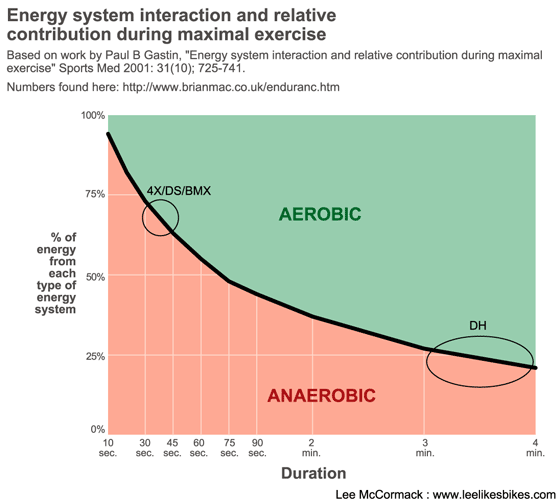The most effective intervals … ever?

I’m about to start Week 12 of a 12-week indoor training program. (Yes, it has sucked. Yes, it has been good for me.)
All this time pedaling in place has me wondering about how our bodies make energy for different length efforts — and, importantly, how busy people can make the most of their training time.
I’m sitting there developing aerobic fitness, which is great for hill climbing, but what about my sprint fu?
Physiology gets super complex. This is super simplified.
First a quick background
Our bodies make energy in two basic ways. Here is the traditional breakdown:
• Anaerobic. High intensity for a short time. To improve anaerobic fitness, you pin it super hard for a short period.
• Aerobic. Lower intensity for a longer time. To improve aerobic fitness, you ride easier for a longer period.
Depending on what you’re training for, your intervals might range from 5 seconds (BMX start power) to 20 minutes (climbing speed). The short intervals are very intense (~100% effort). The long intervals are less intense (~80% effort).
Training plans usually have you perform one type of interval in each workout. That helps you develop the targeted energy system as optimally as possible.
I was wondering …
I want to be solid in any riding situation: BMX, DS, DH, Super D, Pump Track Worlds, commuting, ‘cross adventures, XC rides, whatever.
According to the prevailing wisdom, that means performing intervals of 5 seconds, 10 seconds, 30 seconds, 60 seconds, 3 minutes, 20 minutes … all allocated into carefully crafted system-specific workouts. I don’t have time for all that.
The best all-around riders I know — guys like Brian Lopes, Curtis Keene, Mark Weir, Jon Watt and Brandon Sloan — don’t follow detailed training plans. They simply pin it when they feel strong, and they take it easy when they’re tired.
Question: If I want to be a strong all-around rider (aka “develop all of my energy systems”), do I have to perform all these different structured intervals, or can I simply pin it when I feel strong, and take it easy when I’m tired?
Or: If I’m doing a trainer workout, can I do one type of interval — as hard as I can for a few minutes — and cover everything?
The data I found
http://www.brianmac.co.uk/enduranc.htm has numbers showing the percentage of energy that comes from anaerobic and aerobic energy sources during max efforts from 10 seconds to four minutes long.
I used those numbers to make this chart:
 The only thing chicks dig more than mountain bikes: infographics. |
What it shows:
• If you pin it for a short time, most of the energy is anaerobic. We knew that. Dedicated gated/BMX racers focus on anaerobic training.
• The longer you keep going, the more important your aerobic fitness. We knew that. Dedicated road/XC racers focus on aerobic training.
• At these durations, there is always both an anaerobic and aerobic component. Both types of fitness are important.
• When you look at them this way, 4X/DS/BMX and DH races are opposites! No wonder so few athletes truly excel in both. The athletes who do kick butt at both — Jared Graves, Lopes, Watt, McCormack 🙂 — are well rounded riders.
• If you can hold max effort for four minutes, you’ll tax both your anaerobic and aerobic systems. That was my question.
Conclusions
• Yes! If you pin it as hard as you can for a few minutes, you’ll get a good all-around workout.
• I’m sure more specific workouts would make you strong in more specific ways, but this seems like a very efficient approach.
• This raises more questions than it answers, but I think it’s fun.
The 12-week program is almost over. I can’t wait to go outside and pin it!
— Lee
Know more. Have more fun!
Join the leelikesbikes mailing list:

Leave a Reply
Want to join the discussion?Feel free to contribute!